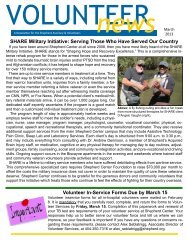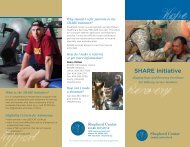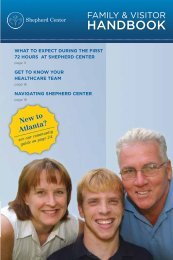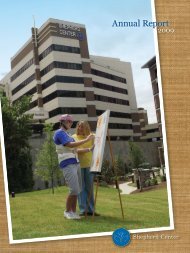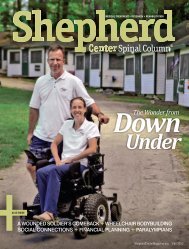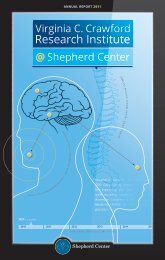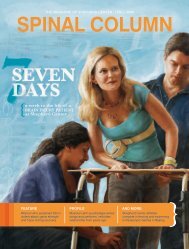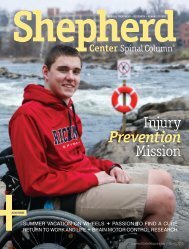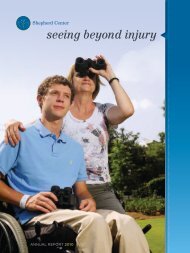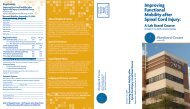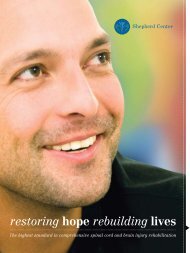the BRAIN - Shepherd Center
the BRAIN - Shepherd Center
the BRAIN - Shepherd Center
Create successful ePaper yourself
Turn your PDF publications into a flip-book with our unique Google optimized e-Paper software.
AssistiveTechnologyFeature<br />
Photo by Gary Meek<br />
Edge with appropriate <strong>Shepherd</strong> patients to see how it can<br />
help <strong>the</strong>m and <strong>the</strong>n determine if it’s an affordable solution<br />
for <strong>the</strong>m. Results elsewhere indicate <strong>the</strong>re is reason to be<br />
optimistic, John notes.<br />
Eyegaze Edge appears to be a promising piece of<br />
technology for improving patients’ quality<br />
of life and restoring some of <strong>the</strong>ir independence.<br />
Eye Control<br />
<strong>Shepherd</strong>’s Assistive Technology <strong>Center</strong> evaluates<br />
vision-based communication and control system<br />
for patients who cannot speak.<br />
By Bill Sanders<br />
<strong>Shepherd</strong> <strong>Center</strong> patient Julius Singleton struggled a bit <strong>the</strong><br />
first time he stared at a computer screen and tried to type out<br />
his name, using nothing but his eyes.<br />
But, with a little practice using a vision-based communication and<br />
control technology called Eyegaze Edge, Julius, a college professor from<br />
Burnsville, W.Va., made progress.<br />
“This technology has <strong>the</strong> potential to transform <strong>the</strong> lives of quadriplegics<br />
whose high-level injuries make it difficult for <strong>the</strong>m to speak and<br />
communicate,” says John Anschutz, director of <strong>the</strong> Assistive Technology<br />
<strong>Center</strong> at <strong>Shepherd</strong> <strong>Center</strong>.<br />
The technology, developed by LC Technologies Inc., gives users numerous<br />
functions including: speech generation, environmental control<br />
(lights, appliances), typing, and running both mouse- and keyboardcontrolled<br />
applications on <strong>the</strong> company’s Edge screen. Also, <strong>the</strong> Edge<br />
can serve as a keyboard and mouse interface for a user’s own computer.<br />
Users make selections by looking at boxes or “keys” displayed on <strong>the</strong><br />
Edge screen. The system uses a pupil-center/corneal-reflection method<br />
to determine where a user is looking on <strong>the</strong> screen. An infrared-sensitive<br />
video camera, mounted beneath <strong>the</strong> system’s screen, takes 60 pictures per<br />
second of <strong>the</strong> user’s eye. The Edge calculates <strong>the</strong> person’s gazepoint (i.e.,<br />
<strong>the</strong> coordinates of where he is looking on <strong>the</strong> screen) based on <strong>the</strong> relative<br />
positions of <strong>the</strong> pupil center and corneal reflection within <strong>the</strong> video<br />
image of <strong>the</strong> eye.<br />
The technology isn’t new to <strong>the</strong> market, but it’s new to <strong>Shepherd</strong><br />
<strong>Center</strong> and its patient population. Ruth Fierman, an occupational<br />
<strong>the</strong>rapist in <strong>the</strong> Assistive Technology <strong>Center</strong>, is testing <strong>the</strong> Eyegaze<br />
If Ruth determines <strong>the</strong>re is potential for <strong>the</strong> Eyegaze Edge<br />
system to be a good match for a patient, one of <strong>Shepherd</strong>’s<br />
speech and language pathology <strong>the</strong>rapists determines if <strong>the</strong><br />
system will provide efficient communication for <strong>the</strong> patient.<br />
As a technology demonstration with Julius shows, Eyegaze<br />
requires practice. Users must learn how to focus on a letter or<br />
statement, such as “I am thirsty,” for <strong>the</strong> right amount of time.<br />
“It can be intimidating until you are familiar with it,” John<br />
says. “Once <strong>the</strong>y get <strong>the</strong> hang of it, though, <strong>the</strong>y want us to<br />
speed it up.”<br />
Physicians expect Julius to regain his voice, but some<br />
o<strong>the</strong>r high-level quadriplegics do not regain that function.<br />
And if <strong>the</strong>y are unable to use a mouse stick in <strong>the</strong>ir mouth,<br />
<strong>the</strong>y have virtually no ability to communicate, John notes.<br />
So Eyegaze Edge appears to be a promising technology for<br />
improving patients’ quality of life and restoring some of <strong>the</strong>ir<br />
independence.<br />
“If someone can’t communicate at all, it is amazingly<br />
frustrating for that person,” John explains. “So, once we finish<br />
evaluating <strong>the</strong> Eyegaze Edge system we have at <strong>Shepherd</strong><br />
now, we hope to get some funding through grants to help<br />
more people. The price of <strong>the</strong>se units has come down from<br />
about $18,000 to $9,000, so we hope, in time, that we can get<br />
<strong>the</strong>m into some homes of people who need <strong>the</strong>m.”<br />
Above: Ruth Fierman, center, an occupational <strong>the</strong>rapist<br />
in <strong>Shepherd</strong> <strong>Center</strong>'s Assistive Technology <strong>Center</strong> (ATC),<br />
evaluates whe<strong>the</strong>r <strong>the</strong> Eyegaze Edge system is appropriate for<br />
quadriplegics who have lost use of <strong>the</strong>ir voice. John Anschutz,<br />
manager of <strong>the</strong> ATC, assists with a demonstration for patient<br />
Julius Singleton of Burnsville, W. Va.<br />
Photo by Gary Meek<br />
1 4 Spinal Column<br />
w w w. s h e p h e r d . o r g



